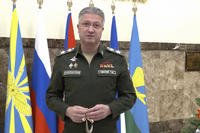Two administration officials gave a House panel the most details yet about the 100 Army Special Forces troops that will be deployed to central Africa, but they also left many questions unanswered on Tuesday.
Why did the Obama administration, which sends thousands of troops into dozens of countries each year to assist their militaries, notify Congress specifically about the SF troops deploying to Uganda? Because, said Donald Yamamoto, the principal deputy assistant secretary of State for African affairs, some of the American soldiers will be accompanying Ugandan and other forces on operations targeting the Lord's Resistance Army. Even though the American soldiers are only going along in a "support role," they'll need to be armed and equipped to defend themselves just in case, Yamamoto said -- hence, President Obama wanted to give Congress a head's up under the War Powers Resolution.
Huh? So Special Forces soldiers could be going along on missions to kill or capture LRA warlord Joseph Kony and his top lieutenants, but they won't be in a combat role, but they will be armed for "self defense?" Although Yamamoto and Alexander Vershbow, the assistant secretary of Defense for international security affairs, assured House members most of the American troops would be in a rear-echelon training and logistics role, it sounded like some will effectively be members of combat patrols.
Committee member Rep. Brad Sherman, a California Democrat, was one of many skeptical lawmakers: Back in Vietnam, when the government said "training," it meant U.S. troops were going on actual patrols with South Vietnamese troops, " training' them to shoot by shooting at the enemy." Isn't that what's really going on here? No, Vershbow insisted -- though he could not rule out that American SF troops might get into hostile contact with the LRA, that was not the purpose of their missions. The point is to help Ugandan, Congolese and other troops get better at finally eliminating Kony and the LRA, he said.
Of course, if the LRA forces shoot first and the government troops have Americans with them, it could turn into a firefight in which the U.S. soldiers "assist" the Africans by fighting right alongside them.
Lawmakers hammered Vershbow for not having a breakdown of what the SF deployment will cost, either overall or by day. He said he was "embarrassed" to have appeared without that information, but he said it would be in the order of "tens of millions of dollars," not hundreds. The operation will last for "months," he said, but there is no set timetable for when the troops must come out. If Kony and his lieutenants are killed or captured, the American soldiers' work will be done. Or if American, Ugandan and the other regional commanders agree they've improved enough with help from the SF troops to continue tracking the LRA on their own, the Americans could come home and let the local forces continue their hunt.
Yamamoto said the US Agency for International Development also is playing a role in the endgame against the LRA: It's helping set up radio and cell phone towers in the vast inter-border region among Uganda, the Central African Republic, Congo and the new country of South Sudan. The idea is that locals can call in if they spot LRA fighters, or they'll be able to get warnings if guerillas are heading their way. One key mission for the SF detachment will be helping Ugandan and other troops "fuse" this and other intelligence into actionable tasking, as well as coordinating all the different militaries' efforts to pursue or box in LRA dead-enders.
DoD and State officials say the local governments have already gotten about 12,000 LRA fighters to abandon the group and return to their homes. What remains are about 800 total fighters and about 150 to 200 hardcore leaders, with Kony at the top. So all right, let's get down to brass tacks here, said Rep. Brian Higgins, a New York Democrat: This is a "capture or kill mission," isn't it?
Yes, Vershbow said -- but the goal is for Ugandan or other central African troops to do the capturing or killing, not the American Special Forces. "We will be advising and assisting them so they can be more effective doing it." All right, said Rep. Robert Turner, a New York Republican -- does that mean the U.S. will be using unmanned surveillance aircraft to watch for Kony? And will commanders be authorized to kill him if a drone spots him?
Vershbow gave a very careful answer -- it sort of addresses John's questions at Defense Tech about what the rules of engagement might be for this operation. Vershbow said: "At the present time, the use of drones is not envisaged in this operation. Questions about the authorities for the use of drone strikes are probably not appropriate for commenting on in an open session like this.”
So -- what does that mean? Even if no commander "envisaged" the use of drones by this morning on the Hill, does that mean one couldn't decide to envisage using them this afternoon? The U.S. already flies drones over Yemen, Libya and probably the Horn of Africa. So it might not be surprising at all if the SF troops making their way to central Africa end up getting UAV support after all.








